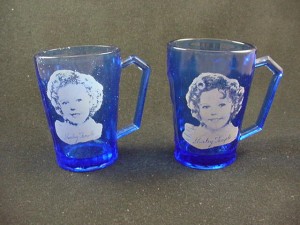Reproductions – The Scourge of the Collecting World – by Rosemary Trietsch
January 11th, 2010 by admin
Reproduction is on left, original on right
Nothing strikes fear in the hearts of collectors like finding out that their beloved collectible is being reproduced. The mere mention of the ‘R’ word causes blood pressure to soar as prices plummet in even the most established collecting market. Yes, reproductions are the scourge of the collecting world. But is it ever acceptable to buy one?
Before answering that question, understand the difference between a ‘reproduction’ and a‘re-issue’. A ‘reproduction’ is a copy of an original, usually made to fool the unsuspecting or un-educated into thinking it’s the real thing. Reproductions are made to deceive. A‘re-issue’, on the other hand, is the re-introduction of a previously produced item by the original issuing company. Re-issues are generally manufactured so as to distinguish them from their older counterpart, thus maintaining the integrity of the original issue.
So, returning to the question, is it ever okay to buy a reproduction antique or collectible? The answer depends on the item.
When it comes to one of a kind items, reproductions are a way for the masses to admire the originals without traveling the world. Everyone knows that the Mona Lisa hanging in your hallway is not the original. Likewise, the Declaration of Independence decorating the school lobby and the Pieta in the church foyer pose no threat to the genuine articles.
When it comes to reproducing styles, like Tiffany style lighting (that ubiquitous term for any stained glass lamp presently being sold on TV) or Mission style furniture, once again, companies are expanding the appreciation of classic design by making it affordable for everyone. As long as they don’t present their Mission chair as authentic Stickley or that butterfly nightlight as newly discovered Tiffany warehouse stock, there’s really no problem with adding such designs to your household décor.
Ah, but when it comes to reproductions that are made to fool the buyer into thinking they are getting the real thing, well, that’s a different thing entirely. There is no justification for buying –or selling – deliberately counterfeited antiques or collectibles. Ask any sports memorabilia collector what they think of fake baseball cards and forged autographs and you’re in for a long and animated recitation. And Lalique collectors will echo their sentiments if you try and convince them that the copy is as nice as the original.
There comes a time in every collectors life when he/she makes a bad purchase and ends up with something that’s not authentic. Everyone makes mistakes, it’s part of the learning process. But don’t compound your mistake by trying to recoup your money by passing the reproduction off to some other unsuspecting collector. Instead, use it as an educational tool: send a picture to your collecting club so they can spread the word. And if it’s one they already know about, then immediately destroy it and think of the money you spent as an investment into the long term value of your collection. When the value of your collection continues to grow, you’ll be thankful you did.
